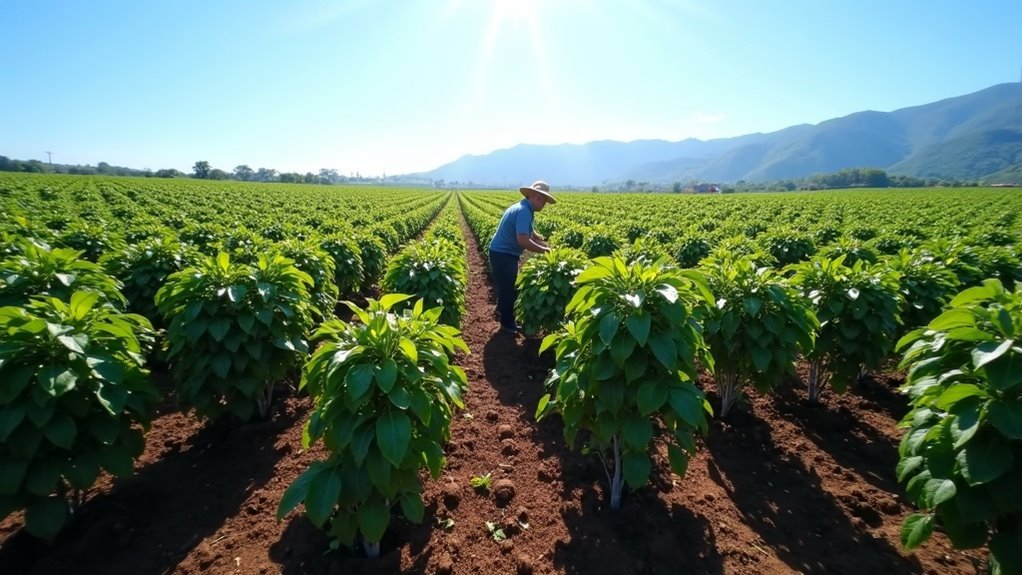Monoculture coffee farming is a method where a single species of coffee is cultivated in uniform rows, designed to maximize yields and streamline the harvesting process. While this approach may boost short-term production, it poses several challenges. Monoculture can degrade soil quality, diminish biodiversity, and make crops more vulnerable to pests and diseases. This often results in an increased dependency on synthetic fertilizers and pesticides, which can pose health risks to farmworkers. Although it may appear efficient at first glance, the long-term economic and ecological ramifications are considerable. There is much to discover about sustainable alternatives and the future of coffee farming that prioritize the health of our planet and communities.
Key Takeaways
- Monoculture coffee farming focuses on growing a single coffee species in uniform rows, aiming to maximize yields and streamline the harvesting process.
- However, this method can lead to compromised soil quality, decreased biodiversity, and increased susceptibility to pests and diseases.
- The historical trend towards monoculture was largely influenced by the rising demand for coffee and the need for more efficient production techniques.
- This farming approach raises several environmental concerns, such as soil degradation, chemical runoff, and potential health risks for workers due to pesticide exposure.
- Sustainable alternatives, including polyculture and agroforestry practices, can help enhance biodiversity and bolster economic resilience for coffee farmers.
Definition and Characteristics of Monocultures
Monoculture coffee farming is a method where a single species of coffee is cultivated in uniform rows, creating an efficient yet potentially harmful agricultural practice. This approach maximizes yields and simplifies mechanical harvesting but often compromises soil quality and biodiversity.
Coffee farms utilizing monoculture expose plants to direct sunlight, increasing vulnerability to pests and diseases. By repeatedly planting the same species, essential soil nutrients deplete, leading to soil degradation and a reliance on synthetic fertilizers.
Ultimately, monoculture can transform vibrant ecosystems into ecological deserts, diminishing the diversity of life vital for maintaining healthy soils and sustainable coffee farming practices.
Historical Context of Coffee Monoculture
As the global demand for coffee surged in the 19th century, farmers began to favor the cultivation of single coffee species over a diverse array of crops. This shift led to the emergence of monoculture farms, where the focus on maximizing coffee production overshadowed the importance of maintaining genetic diversity.
The coffee leaf rust epidemic further accelerated this trend, compelling farmers to adopt monoculture practices as a strategy to mitigate losses. By the mid-20th century, Brazil, now the world’s largest coffee producer, had transformed vast landscapes into expansive single-species plantations.
The industrialization of coffee, along with the rising popularity of instant coffee, solidified these practices, prioritizing efficiency and cost-effectiveness while often neglecting ecological sustainability.
Environmental Impact of Monoculture Coffee Farming
When you consider monoculture coffee farming, it’s hard to ignore its significant environmental impacts.
This method leads to biodiversity loss, soil degradation, and harmful chemical runoff that threaten ecosystems and water quality.
By focusing solely on coffee, these farms create vulnerable environments that struggle to support diverse life forms and resist pests.
It’s essential to recognize these issues as we explore the world of coffee and seek sustainable practices within the industry.
Biodiversity Loss Issues
The shift towards monoculture coffee farming has led to alarming biodiversity loss, as natural ecosystems are replaced with uniform crop plantations. This approach diminishes plant, insect, and animal diversity, creating ecological deserts. With increased reliance on synthetic inputs, vulnerabilities to pests and diseases rise, threatening farmers’ livelihoods.
| Impact | Description |
|---|---|
| Biodiversity Loss | Natural ecosystems are decimated, harming various species crucial for a balanced environment. |
| Soil Erosion | The removal of tree canopies contributes to erosion issues, which can adversely affect coffee quality. |
| Chemical Contamination | Runoff from chemical inputs harms local water sources and ecosystems, impacting the sustainability of coffee farming. |
Soil Degradation Concerns
Soil degradation is a significant concern in monoculture coffee farming, where the relentless cycle of planting the same crop year after year depletes the soil’s nutrients and organic matter.
As coffee farmers heavily rely on synthetic fertilizers, the soil’s composition suffers, leading to reduced fertility and long-term viability essential for coffee cultivation. Many coffee-producing regions face soils becoming unresponsive to these fertilizers, which exacerbates soil health and sustainability issues.
Furthermore, clear-cutting forests for monoculture practices diminishes organic matter, increases erosion, and lowers water retention, all of which are critical for maintaining healthy coffee crops.
Ultimately, soil degradation threatens agricultural productivity, making coffee farmers more vulnerable to economic fluctuations and climate challenges that can impact their livelihoods.
Chemical Runoff Effects
While monoculture coffee farming can yield high production rates, it often comes at a steep environmental cost due to chemical runoff. The heavy use of pesticides and fertilizers leads to significant contamination of nearby water sources, raising serious concerns about water quality.
This runoff can result in nutrient pollution, disrupting aquatic ecosystems and triggering harmful algal blooms that threaten biodiversity. Furthermore, soil degradation from these practices increases erosion, further deteriorating water bodies and aquatic habitats.
Understanding these impacts is essential for coffee enthusiasts and producers dedicated to sustainable practices and the preservation of our natural ecosystems.
Economic Consequences of Monoculture Practices
As coffee farmers increasingly turn to monoculture practices to enhance their short-term yields, they often encounter significant economic risks. This method can lead to economic instability, impacting their livelihoods and the well-being of their communities.
Here are some key consequences:
- Poverty: A striking 44% of coffee farmers live in poverty, with 22% experiencing extreme poverty.
- Market Vulnerability: The heavy reliance on coffee exports renders economies, such as Burundi’s, susceptible to fluctuations in market prices.
- Sustainability Issues: While short-term gains may be realized, they can obscure long-term risks associated with pests or climate change.
- Consumer Impact: Even minor price fluctuations can have a dramatic effect on the economic conditions of farmers.
Recognizing these challenges is crucial for promoting sustainable coffee farming practices.
Health Risks Associated With Coffee Monoculture
When it comes to coffee monoculture, the health risks are significant and often overlooked.
You might be surprised to learn that coffee workers face high pesticide exposure, which can lead to serious health issues not only for them but also for nearby communities.
As these harmful chemicals seep into the environment, they pose risks that extend all the way to your morning cup of coffee.
Understanding these risks is crucial for appreciating the journey of your favorite brew.
Pesticide Exposure Risks
Pesticide exposure poses serious health risks not just for coffee farmers but also for the communities surrounding coffee farms. These risks are alarming, especially given the rising use of pesticides in coffee cultivation.
Here are four key concerns:
- Acute poisoning: Many coffee farmers experience pesticide poisoning, leading to immediate health issues that can affect their ability to work.
- Chronic illnesses: Long-term exposure to pesticides can result in respiratory problems and other severe health conditions, impacting the well-being of those involved in coffee farming.
- Environmental contamination: Pesticides can seep into water sources, posing risks to entire communities that rely on these resources for drinking water and agriculture.
- Consumer risk: Chemicals used in coffee farming may end up in your cup, raising potential health concerns for coffee drinkers who may unknowingly consume residues.
Understanding these risks is vital for making informed choices about the coffee you drink and supporting sustainable farming practices.
Community Health Impacts
While coffee monoculture farming promises higher yields, it also comes with significant community health impacts that shouldn’t be overlooked.
The heavy use of pesticides exposes coffee farmers to alarming health risks, including instances of pesticide poisoning reported in regions like Jamaica and Nicaragua.
In Brazil, pesticide use skyrocketed by 190% in just a decade, raising concerns about chemicals contaminating coffee products.
This not only endangers the farmers’ health but also poses risks to your well-being through daily coffee consumption.
Understanding these dangers is vital for promoting safer coffee farming practices and ensuring the health of both coffee-growing communities and consumers alike.
Occupational Hazards in Farming
The health risks faced by coffee farmers extend beyond community impacts, highlighting serious occupational hazards in the realm of coffee farming.
Pesticides play a significant role in these dangers, leading to various health issues that can affect both farmers and consumers alike. Here are some key concerns:
- Chronic exposure to harmful pesticides can lead to long-term health problems for coffee farmers.
- Farmers often experience acute pesticide poisoning, which can severely affect their immediate well-being.
- Many pesticides used in coffee cultivation are highly toxic and not approved in other regions, raising significant safety concerns.
- Residues from these chemicals may contaminate coffee beans, posing health risks to consumers.
Addressing these occupational hazards is essential for ensuring the safety of coffee farmers and protecting the quality of the coffee we enjoy.
Comparison With Polyculture Coffee Farming
Although monoculture coffee farming aims for high yields, it often falls short in ecological sustainability when compared to polyculture systems. Monoculture relies on rows of identical coffee plants, resulting in reduced biodiversity and increased vulnerability to pests. In contrast, polyculture practices, such as shade-grown coffee, enhance soil health and help reduce erosion.
| Aspect | Monoculture Coffee |
|---|---|
| Biodiversity | Reduced |
| Pest Vulnerability | High |
| Chemical Use | High |
| Crop Quality | Often Lower |
| Economic Resilience | Low |
Transitioning to polyculture can significantly improve resilience and sustainability, making it a more favorable choice for coffee farmers seeking long-term viability.
Sustainable Alternatives to Monoculture
As coffee farmers seek to enhance their practices, sustainable alternatives to monoculture present compelling solutions for the coffee industry. Consider these methods:
- Agroforestry practices: Grow coffee under tree canopies to boost biodiversity and soil health while reducing pesticide use, leading to healthier coffee plants and better flavors.
- Polyculture coffee farming: Integrate other crops alongside coffee to enhance resilience against pests and create alternative income sources, ensuring a more stable livelihood for farmers.
- Sustainable farming methods: Utilize intercropping and crop rotation to maintain soil fertility and manage economic risks from price fluctuations, promoting long-term sustainability in coffee production.
- Shade-grown coffee: Shifting to shade-grown practices protects coffee crops against extreme weather and elevates quality, appealing to ethical consumers who are willing to pay a premium for sustainably produced coffee.
The Future of Coffee Farming: Challenges and Opportunities
While the future of coffee farming presents significant challenges, it also offers exciting opportunities for adaptation and growth.
Climate change threatens to reduce suitable coffee land in Brazil, pushing coffee farmers to explore agroforestry and polyculture systems. These innovative methods can restore soil health, enhance biodiversity, and increase resilience against pests and price fluctuations, which currently leave 44% of farmers in poverty.
Embracing ethical sourcing trends allows consumers to demand sustainably produced coffee, potentially improving economic conditions for farmers.








